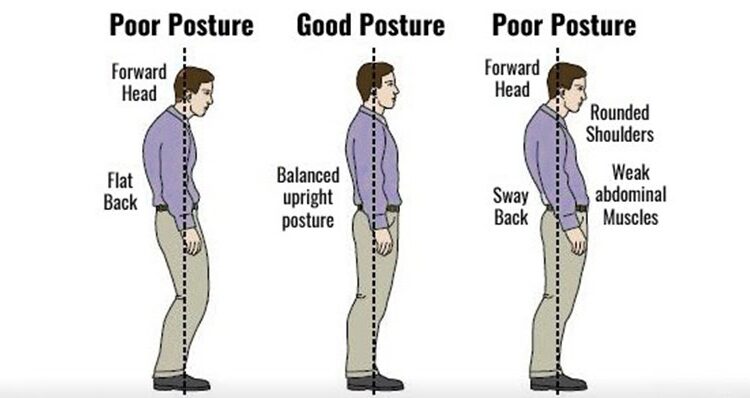Why is good posture important?
By Dr. Annika
If you have seen a chiropractor, chances are they talked about your posture. This isn’t just to make you look better, but also because it has a lot of implications as far as how your body functions in the world goes.
Most of us don’t even know what a good posture looks like, so when we are told “sit (or stand) up straight!” we actually don’t know what that means or how to do it.
As you can see from the picture above, when seen from side-on, the hole in the ear should be straight over the middle of the shoulder, the middle of the hips and just forward of the ankle. (You can check yours when you walk past a plate glass window).
From the back, the spine should be straight and the ears level.
Shoulders and hips should be level. – This is often easier to notice because you can see uneven shoulders in the mirror, and uneven legs often mean one trouser leg appears to be longer than the other.
Why is this important?
If your posture is balanced, it means that the body is balanced around its axis of gravity, which means that it takes minimal effort by the body to keep you upright. That means that you have a lot of capacity to do other things, like moving your arms or walking or thinking. It also means that the rib-cage is nice and open, and breathing is easy.
When shoulders or hips aren’t level, this usually means that there is a scoliosis to a lesser or greater extent – this is something your chiropractor will consider when they treat you.
What does poor posture look like?
Mostly poor posture (when looking from the side) starts with the head creeping forward. This can be because you spend a lot of time with your head forward (eg looking at devices) for example. This is significant beacuse for every inch your head moves forward of the ideal location after the first inch, the effective weight of your head doubles on the neck due to leverage. As a result, the muscles at the back of your head suddenly aren’t just in charge of slightly correcting your posture to keep you upright, they have to physically work anytime you are upright to pull your head back. These muscles are built for endurance, not strength. The big muscles at the back of your neck (upper trapezius) attach at the shoulders, and it’s no wonder that so many people experience pain and discomfort here when you consider that fact.
Why does poor posture happen?
If you look at small children, they all have fantastic postures. This is because their heads (not faces) reach adult size at the age of 3, while their bodies obviously still have a lot of growing to do, so there is a real imperative to keep the head where it belongs, centered around the axis of gravity. Down the track, the relative weight of the head lessens as the body grows, and heads are forward working on devices or reading or pens to paper, and the body then tends to learn that this is where the head belongs.
Stress will also create this posture, as it is part of the fight-or-flight stance.
If you have had accidents and the spine has straigtenend as a result, ie. has lost the forward curvature in the neck has been lost, the end result is often a forward head carriage as well.
Over time, with mis-use and accidents and fatigue, this becomes more and more pronounced.
In people with altered bone structure (Scheuerman’s in the young or compression fractures of the spine later in life) this can happen as a result of an excessive curve in the upper back.
Usually what follows is a slumping of the shoulders, which reduces the excursion of the rib-cage for breathing, which means that all of a sudden a basic survival activity – breathing – requires a reasonable amount of effort – energy better spent on other (fun) things! The space in the abdomen for the internal organs is compromised too, which is likely to impact their function at least on a subclinical level. Then the lower back is altered to compensate and you have set yourself up for back pain, too.
Strategies to stay straight!
So in order to keep yourself upright and happy and youthful,
- Get adjusted! If there are restrictions in your spinal joints and the muscles around them the body will not straigthen out with any degree of ease.
- You can practice walking with a book balanced on your head and
- check your posture every time you walk past a plate glass window to make sure you are in alignment.
- Lie on your back with a rolled-up towel under your chest and stretch your arms out to the side and up to open your chest and keep your upper back flexible.
- Take up an activity that emphasizes posture, like Pilates or Yoga or T’ai Chi.
- Make sure you don’t bend your head down all the time to look at your devices.
- Play on swings and merry-go-rounds and moneky bars (especially if you are a child) as an accurate sense of where we are in space helps good posture enormously and also strengthens postural muscles.
- And spend time playing and exercising in nature, particularly with shoes off, so your body can move freely and hold itself where it needs to.

